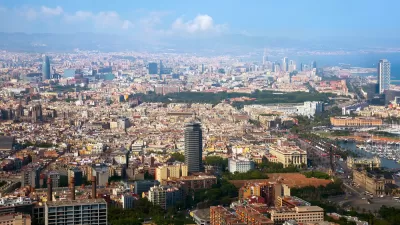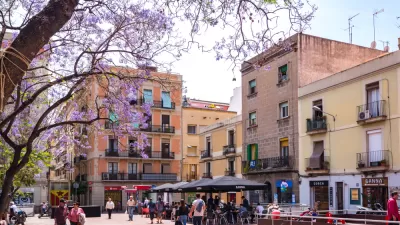Two weeks ago, after nearly two decades of waiting, Barcelona urban designer Salvador Rueda finally saw the first "Superilla" (Superblock) installed in the city. The superblock faced fierce opposition from unhappy residents and local businesses.
Rueda, who has led the Urban Ecology Agency of Barcelona since the year 2000, envisioned the superblock in 2002 when he was reorganizing the city’s old bus routes, a legacy of the industrial era. (See previous post: Superblocks, Barcelona Answer to Car-Centric City.)
A Superblock, according to Rueda, is defined by a grid of nine blocks where the main mobility happens on the roads around the outside of the Superblock, and the roads within are only for local use. The one-way system inside the Superblock makes it impossible to cut through to the other side, while still giving neighbours access to their garages and parking spaces. So the Superblock remains free of through traffic.
Superblocks are already at work in several cities in Spain, but Barcelona could be their best iteration because of the grid pattern of the Eixample, a broad swath of the city designed by Idelfons Cerdà back in the 1850s when Barcelona was rapidly expanding.
Last week’s official presentation of the first superblock in the Poble Nou neighborhood faced some fierce opposition from unhappy residents and local businesses complaining about loss of curbside parking, changes in street direction, and the installation of the superblock itself right after the summer holidays and without prior warning, they claimed.
The superblocks project also faces opposition from within the city council. After the installation of the pilot, some council members from the opposition parties asked for it to be dismantled and any further superblocks to be put on hold. Mercedes Vidal, Barcelona's councilor of mobility, was critical of that attitude, pointing out that some of those same people had approved the mobility plan and superblocks project under a prior administration.
Maria Rubert, professor of urbanism at the Architecture School of the Universitat Politècnica de Catalunya · BarcelonaTech, agrees that the superblocks will increase the quality of life for those people living inside the block. But she wants the city to consider other solutions for residents on streets that carry most of the traffic, such as imposing a congestion charge for cars entering the city (similar to the one in London), reducing the number of lanes and limiting the speed on main thoroughfares that cross the city.
Unfortunately, Barcelona is very accommodating to cars, Rubert says. Being a small, compact city, makes it easy to move around in a private vehicle, with most trips taking less than 15 minutes. Some streets of Barcelona are being used as motorways, she adds. It is important to “calm” all the main streets of Barcelona and divert through traffic outside the city center. It is not right, she says, that some residents should enjoy the pedestrian areas in the superblocks while others face streets full of traffic, noise, and pollution.
FULL STORY: Barcelona’s first Superblock, Fighting the Power of Habit and Wavering Political Will

Planetizen Federal Action Tracker
A weekly monitor of how Trump’s orders and actions are impacting planners and planning in America.

The Simple Legislative Tool Transforming Vacant Downtowns
In California, Michigan and Georgia, an easy win is bringing dollars — and delight — back to city centers.

San Francisco's School District Spent $105M To Build Affordable Housing for Teachers — And That's Just the Beginning
SFUSD joins a growing list of school districts using their land holdings to address housing affordability challenges faced by their own employees.

In More Metros Than You’d Think, Suburbs are Now More Expensive Than the City
If you're moving to the burbs to save on square footage, data shows you should think again.

The States Losing Rural Delivery Rooms at an Alarming Pace
In some states, as few as 9% of rural hospitals still deliver babies. As a result, rising pre-term births, no adequate pre-term care and "harrowing" close calls are a growing reality.

The Small South Asian Republic Going all in on EVs
Thanks to one simple policy change less than five years ago, 65% of new cars in this Himalayan country are now electric.
Urban Design for Planners 1: Software Tools
This six-course series explores essential urban design concepts using open source software and equips planners with the tools they need to participate fully in the urban design process.
Planning for Universal Design
Learn the tools for implementing Universal Design in planning regulations.
Smith Gee Studio
City of Charlotte
City of Camden Redevelopment Agency
City of Astoria
Transportation Research & Education Center (TREC) at Portland State University
US High Speed Rail Association
City of Camden Redevelopment Agency
Municipality of Princeton (NJ)




























